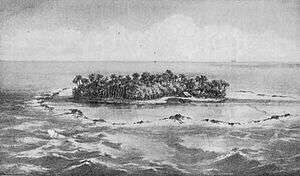Nukapu Expedition
| Nukapu Expedition | |||||||
|---|---|---|---|---|---|---|---|
 Nukapu, circa 1870. | |||||||
| |||||||
| Belligerents | |||||||
|
|
| ||||||
| Commanders and leaders | |||||||
|
|
| ||||||
| Casualties and losses | |||||||
|
1 killed 2 wounded 1 sloop-of-war damaged |
20-30 killed ~3 war canoes sunk | ||||||
The Nukapu Expedition occurred between October 1871 and February 1872 and was a British punitive operation in response to the murder of Bishop John Coleridge Patteson by the natives of Nukapu. A Royal Navy warship was sent to the island and it sank a group of hostile war-canoes and landed men to attack a fortified village.
Expedition
In October 1871, the screw sloop-of-war HMS Rosario was operating against South Seas blackbirders when her captain, Acting-Commander Albert Hastings Markham received orders to sail for Nukapu in the Solomon Islands. A contemporary newspaper described the events thus:
| “ | The Rosario's boat had got to within 50 yards of the mainland when the natives commenced their war dance and made other hostile indications. They then sent a shower of arrows at the Rosario's boat, which however, all fell short. The boat then returned to the ship to report the attack, and to ask permission to return it. The boat was ordered to return, and the ship was cleared for action, and opened fire with shell from the 40-pounder Armstrong, and the 7in. six and a half ton gun; while the crew of the boat opened fire with their rifles. The Rosario made a circuit of the island, and when abreast of the native village fired on it with shell at 2,300 yards. At 4 p.m., it being high water, the boats were able to cross the reef, and four of them advanced on the village with small arms, and engaged the natives, who kept up a continual discharge of arrows; the ship sent in shell at a range of a mile. After firing several hundred rounds, the men landed from the boats and drove the natives in from the beach. Here one of the arrows struck Corporal Marcus in the arm, and the wound afterwards proved fatal. The native canoes were destroyed, and the seamen pulled on to the village, where one of them received two bad wounds, but ultimately recovered from their effects. The village proved to be very strongly fortified with stonework, which was thrown up in front of each hut. In a few minutes the native habitations were set in flames. It was estimated that from 20 to 30 natives were killed in the engagement. | ” | |
| — The Rosario and the Murderers of Bishop Patteson, reported in The Argus[1][2] | |||
Markham published an account of the cruise under the title The cruise of the Rosario amongst the New Hebrides and Santa Cruz Islands, exposing the recent atrocities connected with the kidnapping of natives in the South Seas.[3] The measures taken by Rosario became the subject of questions in the House of Commons,[4] and Markham's book[3] on the subject may well have been prompted by them. The book itself makes clear that Markham clearly understood the cycle of violence and deplored both the murderous activities of the Blackbirders, and the apparent need for further violence in restoring order.[3]
See also
References
- ↑ "The Rosario and the Murderers of Bishop Patteson". The Argus. Melbourne. 15 February 1872.
- ↑ Montgomery, pg. 32-323
- 1 2 3 Markham, Albert Hastings (1873). The cruise of the Rosario amongst the New Hebrides and Santa Cruz Islands. London: Sampson Low, Marston, Low, and Searle.
- ↑ "Hansard, 11 March 1872". Retrieved 2009-11-19.
Mr W Johnston asked the Under Secretary of State for Foreign Affairs, If there is any foundation for the statement that Her Majesty's ship Rosario has shelled and destroyed the village in the Island of Nukapu, in which resided the natives who murdered Bishop Patteson; and, if so, by whose orders this was done?
- Montgomery, Charles (2004). The Shark God: encounters with ghosts and ancestors in the South Pacific. HarperCollins Publishing. ISBN 0-06-076516-X.